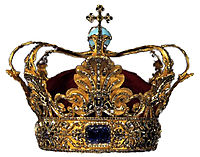- Crown of Christian V
-
The crown of King Christian V of Denmark was the crown used at the coronation of all of Denmark's absolutist kings, see Absolute monarchy. While the reign of such monarchs ended in 1840, the crown is still used during a Danish king's castrum doloris, the last time in 1972.
Used by the kings from Christian V to Christian VIII. Made by Paul Kurtz in Copenhagen, 1670-1671. Gold with enamel and table-cut stones. Total weight 2080 g. Also 2 garnets and 2 sapphires, of which the largest dates back to Frederick I of Denmark.
Frederik III had large parts of his daughters' trousseau bought in Paris, which, already at that time, was a centre for European fashion. But the jewellery was commissioned to Kurtz. He was, therefore, considered an outstanding jeweller. In 1670-1671 he made his principal piece of work, Crown of Christian V. The closed shape was inspired by the crown of Louis XIV of France, but Kurtz replaced the lily-shaped points of the French crown with palmettes and adorned the crown with a row of diamonds intertwined with palmette and acanthus. In that way a "white" play of light was created, which was framed by blue and red in the sapphires and garnets of the crown ring and the orb and cross in the top.
The crown forms part of the National Coat of arms of Denmark and the Royal Coat of arms. Since 1671, the crown has been the de facto symbol of the state power. It is included in stylized and varied forms in most state institutions, including ministries.
References
Crowns English, Scottish, Welsh
and British crowns
(by chronology)Palatine Crown · Crown of Scotland · St Edward's Crown · Crown of Mary of Modena · State Crown of George I · Coronet of Frederick, Prince of Wales · Coronation Crown of George IV · Crown of Queen Adelaide · Imperial State Crown · Small diamond crown of Queen Victoria · Crown of Queen Alexandra · Coronet of George, Prince of Wales · Crown of Queen Mary · Imperial Crown of India · Crown of Queen Elizabeth · Coronet of Charles, Prince of WalesHoly Roman Empire,
German, Austrian,
Bohemian
and Italian crownsIron Crown of Lombardy · Reliquary Crown of Otto II · Crown of Otto III · Reliquary Crown of Empress Cunigunde · Reliquary Crown of Henry II · Imperial Crown of the Holy Roman Empire · Salian Funeral Crowns of Spires · Kamelaukion of Frederick II or Constance of Sicily · Reliquary Crown of Charlemagne (14th century) · Crown of St. Wenceslas (Bohemian lands) · Crown of Blanche of Valois (Bohemian lands) · Electoral Hat of Saxony · Ducal hat of Styria · Archducal hat (Archducal hat of Tyrol · Archducal hat of Joseph II) Crown of the Grand Duchy of Tuscany · Imperial Crown of Austria · Crown of Frederick I (Prussia) · Crown of Charlotte (Prussia) · Imperial Crowns of Charles VII · Napoleonic Crown of Italy · Royal Crown of Bavaria · Royal Crown of Württemberg · Royal Crown of Hanover · Grand Ducal Crown of Baden · Crown of Empress Elizabeth (Austria) Crown of Wilhelm I (Prussia) · German State Crown · Crown of Wilhelm II (Prussia)Polish crowns Crown of Bolesław I the Brave · Swedish Crown · Muscovy Crown · Hungarian Crown · Homagial Crown · Funeral Crown · Queens Crown · Crown of Augustus II · Crown of Augustus III · Crown of Maria Josepha · Płock DiademRussian crowns "Cap of Monomakh" · Crown of Kazan Tzardom · Crown of Tsar Michael Fyodorovich · Cap of Monomakh of the second set · Diamond crown of Tsar Peter I · Diamond crown of Tsar Ivan V · Altabas crown of the third set · Crown of Empress Catherine I · Crown of Empress Anna Ivanovna · Great Imperial Crown · Maltese Crown · Small Imperial CrownFrench crowns Crown of Charlemagne · Sainte Couronne · Crown of Louis XV · Crown of Napoleon I · Crown of Charles X · Crown of Napoleon III · Crown of Empress EugenieOther European crowns Crown of Crown Prince Carl (Norway) · Crown of Christian IV (Denmark) · Crown of Christian V (Denmark) · Crown of Zvonimir (Croatia) · Crown of Eric XIV (Sweden) · Crown of William I (Netherlands) · Crown of William II (Netherlands) · Crown of Norway · Crown of Portugal · Crown of the Queen of Norway · Crown of Elisabeta (Romania) · Crown of Maria (Romania) · Holy Crown of Hungary (Hungary) · Crown of Peter I (Serbia) · Crown of Martin of Aragon · Royal Crown of Spain · Crown of Greece · Papal Tiara · Crown of Rus (Ukraine) · Steel Crown of RomaniaNon-European crowns Crown of Faustin I (Haiti) · Empress Crown (Iran/Persia) · Great Crown of Victory (Siam/Thailand) · Kiani Crown (Iran/Persia) · Imperial Crown of Brazil · Imperial Crown of Mexico · Crown of Sri Vikrama Rajasinha of Sri Lanka · Pahlavi Crown (Iran/Persia) · Crown of Silla (Korea) · Crown of Hawaii · Crown of Tahiti · Crown of Madagascar · Crown of Ranavalona III · Silver crown of Emperor Tewodros (Ethiopia)See also Coronation · Crown Jewels · Heir Apparent · Heir Presumptive · King · Monarchy · Queen · Regalia · Royal FamilyCategories:- Crown jewels
- Crowns
- Danish monarchy
- Regalia
- State ritual and ceremonies
- Visitor attractions in Copenhagen
- Royalty stubs
- Denmark stubs
Wikimedia Foundation. 2010.

